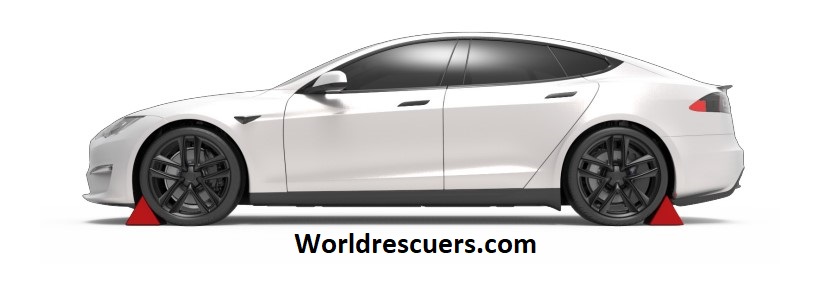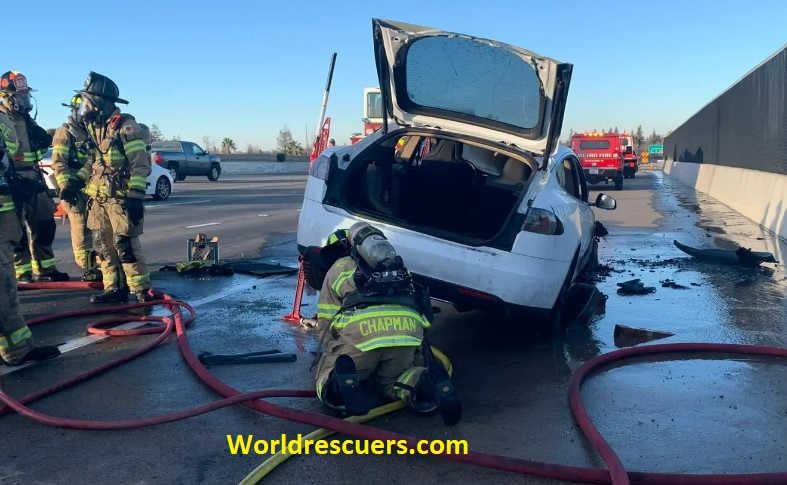
Tesla Fire
A Tesla fire refers to a fire that occurs in a vehicle manufactured by Tesla Inc., an American electric vehicle and clean energy company. The term is typically used to describe a fire that occurs as a result of a battery-related incident in a Tesla vehicle, such as a thermal runaway event.
Tesla vehicles use lithium-ion batteries to power their electric motors, and while these batteries are generally considered safe, they can pose a fire risk if damaged or improperly handled. In rare cases, a damaged or defective battery can lead to a thermal runaway event, which is a self-perpetuating chemical reaction that can cause the battery to overheat and ignite.
When a Tesla fire occurs, it can be dangerous and difficult to extinguish due to the nature of the lithium-ion batteries. However, Tesla has implemented safety features in their vehicles to help prevent fires and protect occupants in the event of an incident. Additionally, the company has worked to improve battery technology and address safety concerns related to its vehicles.
Total Tesla Fires incidents
Tesla has experienced several high-profile fire incidents throughout its history. Here is a brief overview of some of the major incidents:
2013:
Model S Tesla catches fire – In 2013, there were three separate incidents in which Model S Tesla catches fire. These incidents were widely covered by the media and led to a drop in Tesla’s stock price. However, the company was quick to respond and implemented changes to the vehicle’s firmware to reduce the risk of fire.
2018:
Model S Tesla catches fire – In 2018, a Model S caught fire after crashing into a wall at high speed in Florida. The driver died in the incident, and the National Transportation Safety Board launched an investigation into the incident.
2019:
Shanghai Model S Tesla catches fire – In 2019, a Model S caught fire while parked in a parking lot in Shanghai, China. The incident was widely covered by the media and raised concerns about the safety of Tesla’s batteries. However, Tesla was quick to respond and launched an investigation into the incident, ultimately determining that the fire was caused by a single battery module and was not indicative of a systemic issue.
2020:
Model S Tesla catches fire – In 2020, a Model S caught fire after crashing into a tree in Texas.
A total 182 fire incidents have been reported till now and 98 out of these are from the USA. Whereas o3 and 05 Fire incidents in Tesla have been reported from UK and Canada to Date.
It’s worth noting that while Tesla has experienced several high-profile incidents over the years, the overall safety record of its vehicles is generally considered to be very good. The company has implemented several safety features in its vehicles, and it continues to work on improving the safety of its batteries and other components.
The right way for firefighters to response Tesla on Fire
Steps to put out Tesla Fires
Identification
A lack of engine noise does not mean the vehicle is off. Silent movement or instant restart capability exists until the vehicle is fully Shut down. Wear appropriate personal protective equipment (PPE). Model S can be identified by its badges, vehicle identification number, etc.

The model’s name does not appear on the rear of the vehicle.
Stabilization
Stabilization of Tesla on fire vehicles is possible by using different techniques and tools. Chocking wheels, and putting the vehicle in Park position, are the common ways for stabilization.

Risk assessment and mitigation of Hazards
Identification of possible potential hazards and calculation of risk factors is the prime step to take upon responding to the fire incident. High voltage, Low voltage, and stored gas of airbags, etc. are the common hazards that must be mitigated before the start of the operation. The firefighters should consider Electrocution and remain prepared for first aid.
Access to the occupants or passengers
Foreseeable entries through side doors and rare cabins are the main ways to access the occupants of Tesla on fire. It is recommended to avoid the high strengthen zone of the vehicle to choose for entry.
Start Firefighting in the right way
Using only water to fight a high voltage battery of Tesla on fires requires a high amount of water to cool. As a firefighter, always arrange backup water while responding to the Tesla on Fire. If water is not immediately available on the incident site, use CO2, dry chemicals, or another typical fire-extinguishing agent.
NOTE: Tesla does not recommend the use of foam on electric vehicles.
Frequently asked related questions
Why is tesla fire so hard to put out?
Tesla fires can be difficult to put out because of the unique properties of the lithium-ion batteries used in Tesla vehicles. Lithium-ion batteries are lightweight and powerful, making them a popular choice for electric vehicles. However, they are also highly flammable and can release large amounts of energy in the form of heat and gases if they are damaged or overcharged.
When a lithium-ion battery catches fire, it can be very difficult to extinguish because the fire can reignite even after it appears to be out. This is because the electrolyte inside the battery is a flammable liquid, and even small amounts of the liquid that remain after the initial fire can reignite under certain conditions.
Additionally, lithium-ion batteries can release toxic gases when they burn, which can pose a risk to firefighters and other first responders. These gases can include hydrogen fluoride, which can cause severe burns and respiratory damage, and hydrogen cyanide, which is a deadly poison.
To help address these issues, Tesla has developed safety features in their vehicles to help prevent fires and protect occupants in the event of an incident. For example, Tesla’s battery packs are designed with firewalls and cooling systems to help contain and dissipate heat in the event of a battery-related incident. The company also provides guidance to first responders on how to safely extinguish a Tesla fire, including instructions to use copious amounts of water and to avoid piercing the battery pack with sharp objects.
How did tesla car catch fire?
There are several ways that a Tesla car can catch fire, but the most common cause is damage to the battery pack. Tesla vehicles use lithium-ion batteries to power their electric motors, and while these batteries are generally considered safe, they can pose a fire risk if damaged or improperly handled.
For example, if a Tesla vehicle is involved in a high-speed collision, the battery pack can be damaged, causing the battery to overheat and potentially ignite. Similarly, if the battery is damaged during a repair or maintenance procedure, it can also pose a fire risk.

In addition to physical damage, other factors can contribute to a Tesla fire. For example, if a battery is overcharged or exposed to high temperatures, it can cause a thermal runaway event, which is a self-perpetuating chemical reaction that can cause the battery to overheat and ignite.
It’s worth noting that while Tesla fires can be serious, they are relatively rare compared to other types of vehicle fires. Tesla has implemented safety features in their vehicles to help prevent fires and protect occupants in the event of an incident, and the company continues to work on improving the safety of its batteries and other components.
How much is a tesla battery?
The cost of a Tesla battery varies depending on the model and the size of the battery pack. Here is a rough breakdown of the cost of a Tesla battery based on the company’s current lineup:
Model S:
The Model S comes with either a 100 kWh or 130 kWh battery pack, which Tesla says has a range of up to 405 miles and 520 miles, respectively. According to Tesla’s website, the cost of a replacement battery for the Model S is currently around $22,500.
Model X:
The Model X comes with either a 100 kWh or 130 kWh battery pack, which Tesla says has a range of up to 360 miles and 480 miles, respectively. According to Tesla’s website, the cost of a replacement battery for the Model X is currently around $22,500.
Model 3:
The Model 3 comes with either a Standard Range battery pack (which has a range of up to 263 miles) or a Long Range battery pack (which has a range of up to 353 miles). According to Tesla’s website, the cost of a replacement battery for the Model 3 ranges from $7,000 to $10,500, depending on the size of the battery pack.
Model Y:
The Model Y comes with either a Standard Range battery pack (which has a range of up to 244 miles) or a Long Range battery pack (which has a range of up to 326 miles). According to Tesla’s website, the cost of a replacement battery for the Model Y ranges from $7,000 to $10,500, depending on the size of the battery pack.
It’s worth noting that these prices are for replacement batteries and do not include the cost of installation, which can vary depending on the location and the complexity of the installation. Additionally, Tesla offers a battery warranty on its vehicles, which covers the cost of a replacement battery if it fails due to defects in materials or workmanship.
Please do not forget to share your feedback here or on social media Platforms

Hi, I am John Smit a Captain in Fire Department City of Newyork with over years of experience in the field of Firefighting and HSE. My passion for fire safety started when I was a young boy and witnessed a neighbor’s house go up in flames along with precious lives. Since then, I had dedicated my life to ensuring the safety of buildings, properties, and individuals in case of a fire and medical emergencies.

